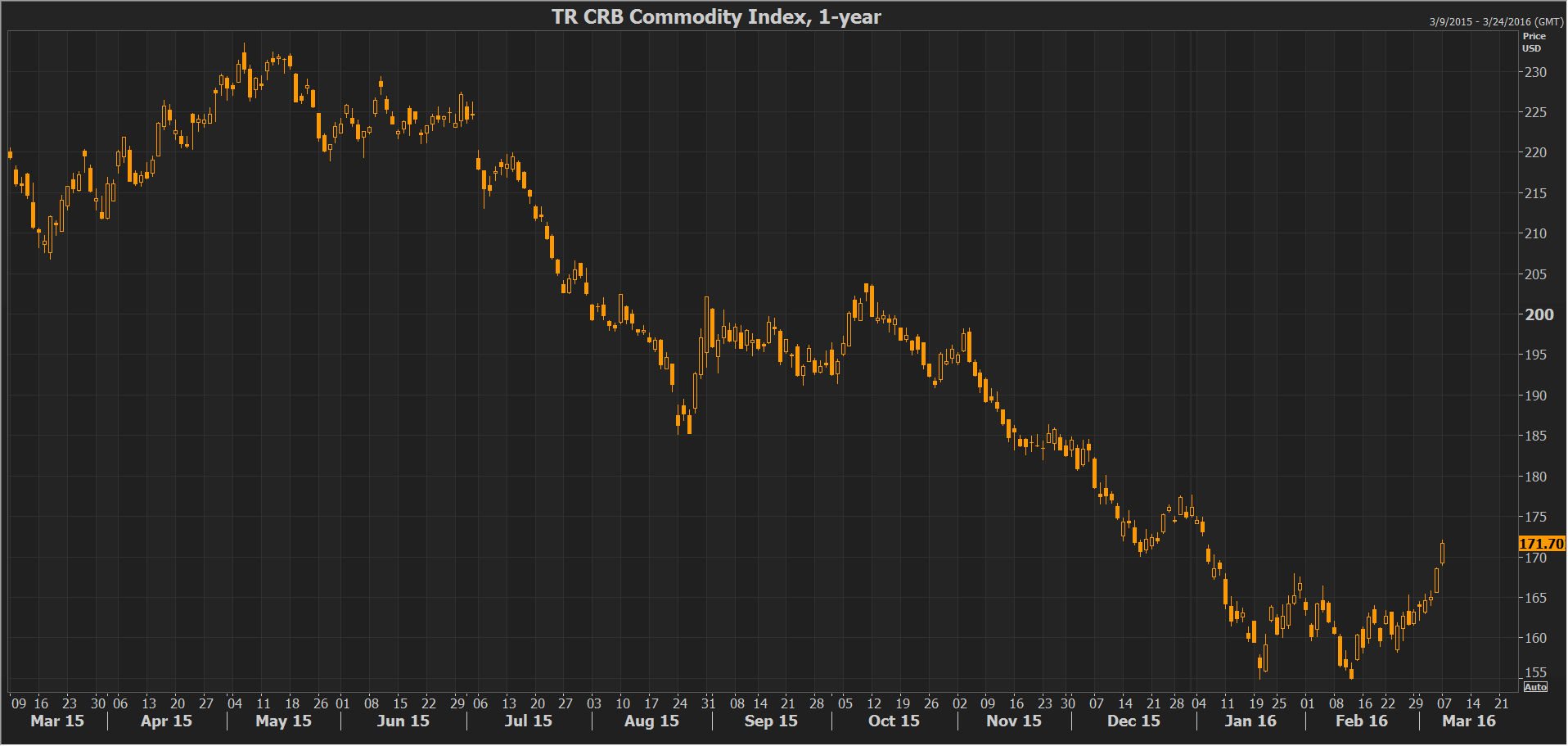Together with oil, gold is the other key commodity which market participants keep an eye on. Gold has climbed by more than $200 since the end of last year to around $1270 an ounce. The advent of ultra-loose monetary policies in the form of negative interest rates has benefited gold as has some of the uncertainty about the global economy and financial system vulnerabilities.
Another key commodity that has seen an impressive rally was iron ore as it has risen from around $38 a ton in mid-December to around $64 in latest trading in China.
The stabilization of commodities and the rally in oil prices from their lows in particular, has led to improved risk sentiment as markets saw excessive weakness in the oil price as something worrying in the global economy rather than a benefit to oil-consuming developed economies.
Although the commodity rally from the lows has been an impressive one, it should also be put in perspective. At 170, the index is quite far away from its 2011 peak of around 370 and even further away from its pre-crisis 2008 high of 473. A bounce off lows is an expected event and unless prices gain even more traction, it is difficult to say that the market has turned. Furthermore, it is not clear whether the conditions exist for a sustainable commodity upcycle. For example, global economic growth is expected to slow down during the year, with China, the world’s largest consumer of commodities, slowing down further and switching the focus of its economy away from commodity-hungry manufacturing and construction towards services. True commodities are probably quite cheap given all the beating they have taken for the past 5 years, but it remains to be seen if they can sustain certain levels and not fall to new lows.
Currencies that dance to the commodity tune: Australian and Canadian dollar
It has therefore also been an exciting time for traders that are preoccupied with the loonie and the aussie; two major currencies that are sensitive to commodities. Starting with the Australian dollar, the latest update is that the aussie made an 8-month high versus the US dollar, as it successfully managed to scale the 74 cents level; a level which caused problems for the aussie back in October and November of 2015. The aussie has been greatly helped by the rally in iron ore prices, which is a key Australian export. Positive risk sentiment, the expectation that the RBA will keep interest rates unchanged for the time being and better-than-expected economic growth and employment, have also been helping. The aussie as always remains vulnerable to negative news out of China, as was the case earlier today when disappointing Chinese trade statistics were published and there was some serious profit-taking in the aussie. The fact that the RBA Deputy Governor also sounded a note of caution with respect to the currency’s strength did not help either.
Turning attention to the Canadian dollar, the loonie made a three-month high versus the US dollar as the rebounding oil price boosted the fortunes of the currency. The loonie pushed the dollar below 1.33 from a high above 1.46. Interestingly, traders are reluctant to push the rate even lower during the last 2-3 sessions when oil made fresh highs, as if waiting for confirmation that the price of oil, which reached its highest since the beginning of January, is going to keep these gains. Both currencies are expected to remain volatile and attract a lot of trader attention in view of the sharp moves witnessed in commodity markets.

Forex trading and trading in other leveraged products involves a significant level of risk and is not suitable for all investors.
Recommended Content
Editors’ Picks
AUD/USD dips below 0.6600 following RBA’s decision

The Australian Dollar registered losses of around 0.42% against the US Dollar on Tuesday, following the RBA's monetary policy decision to keep rates unchanged. However, it was perceived as a dovish decision. As Wednesday's Asian session began, the AUD/USD trades near 0.6591.
EUR/USD edges lower to near 1.0750 after hawkish remarks from a Fed official

EUR/USD extends its losses for the second successive session, trading around 1.0750 during the Asian session on Wednesday. The US Dollar gains ground due to the expectations of the Federal Reserve’s prolonging higher interest rates.
Gold wanes as US Dollar soars, unfazed by lower US yields

Gold price slipped during the North American session, dropping around 0.4% amid a strong US Dollar and falling US Treasury bond yields. A scarce economic docket in the United States would keep investors focused on Federal Reserve officials during the week after last Friday’s US employment report.
FTX files consensus-based plan of reorganization, awaits bankruptcy court approval

FTX has filed a consensus-based plan for its reorganization, coming almost two years after the now defunct FTX filed for Chapter 11 Bankruptcy Protection in the District of Delaware.
Living vicariously through rate cut expectations

U.S. stock indexes made gains on Tuesday as concerns about an overheating U.S. economy ease, particularly with incoming economic reports showing data surprises at their most negative levels since February of last year.